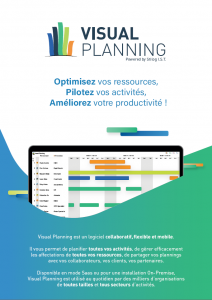As a project manager or director of operations, you had the bright idea to implement a scheduling solution for your team. You realized that it would be the most efficient way to improve your organization’s resource management and productivity. You managed to sell the idea to management with flying colors and even purchasing gave its blessing (well done!). Everything is perfect! Except one (huge) detail you might have forgotten: the end user. Yes that employee in your team who will have to use the scheduling tool on a daily basis.
End users should be a pivot point in your software selection process. In fact the success of the implementation will depend on them to a large extent. What if they totally reject the scheduling solution you chose? In general, change is not an easy thing to go through. At work, even though it becomes absolutely necessary at some point, we all know that the innovation or change process can go through a very rough path. Some people just don’t find it that thrilling and one’s comfort zone- as its name claims it – is always so comfy, so why would they bother changing? When implementing a new scheduling tool, employee might even find it really disturbing that you thought you needed a scheduling program to begin with.
To them, it could feel like you were implying a lack of organization on their part. Or like you would like control how they manage their typical workday. But you came to a point where having a scheduling solution became essential to run your business. The success of its implementation depends a lot on the end user adoption. Therefore, solutions have to be found to deal with change management. You do not want to spend money on a solution that will be a complete flop internally. That is why I decided to work on a few tips to help you implement new scheduling software smoothly. I make sure that your team adopts it very quickly.
CREATE THE APPROPRIATE ENVIRONMENT
If there was one best practice to follow, I would definitely pick this one over a thousand. You must focus on change management from start to end. This is the perfect time to create an honest teamwork environment. Everything will be explained and discussed, step by step. Prepare your teams because there is nothing worse than being taken by surprise for such an important thing (which would also create an unpleasant oppressive atmosphere). To do so, you should make sure to explain the reasons for your choice. In parallel they understand why they absolutely need a scheduling tool right from the beginning. Make your team understand what you think is flawed or inefficient in your current processes. Don’t hesitate to outline some pragmatic goals for your project. In other words, they must understand how they can individually benefit from the tool as much as the organization will.
INVOLVE THE FINAL USERS
It is time for you to sell the idea… but to your team this time. Most of end users we hear complain, explain how their boss picked an inadequate scheduling solution instead of asking them what they really needed. This kind of reaction clearly shows that when a decision has to be made, employees like to be involved. Especially when your decision will directly impact their workday and habits. I would clearly advice you to let them talk so that you can listen to them and understand what makes them tick. A great idea would be to create group sessions where you could make everyone participate to the creation of the perfect scheduling solution checklist. The only way to avoid a conflict is to involve them in the decision process. You would be surprised to see how people can get accommodating when things are properly asked and explained.
MAKE SURE THE TOOL IS EASY TO USE
It can’t be said too many times, selecting a user-friendly tool should be at the very top of your list of goals. Nice ergonomics, easiness to use and nice design are always enjoyable for a user. Depending on your team members’ profile, some end users might only have basic IT knowledge. So if you hit them with a complex solution they may get bored or feel that the hill is too high to climb. Worst case scenario, they may continue to use the old system on the side because they know how it works. A lot of scheduling solutions on the market are very user-friendly with a simple design and intuitive features. Just make a clear list of your technical and functional requirements and go for it!
CHOOSE AN AMBASSADOR
This tip could prove to be really useful when it comes to get a new scheduling tool accepted or smooth the waters with your team. There’s always some kind of an unofficial leader among peers. For example someone with charisma or seniority who is curious, motivates and inspires people. And usually these people are always up for a challenge, so make them the ambassador of the scheduling tool. You could be the ambassador yourself. But as a manager you are primarily perceived as having an agenda that is more aligned with upper management’s wishes than employees’ true needs. While that other person is perceived as more neutral in their choice, your team is more likely to hear and accept what they say.
SCHEDULE TRAINING SESSIONS
Even if you go for the most user-friendly scheduling tool, your team will probably need a few sessions to get around it. Don’t make the mistake to think that they will get on board and learn by themselves. You will just lose a tone of time and your team will feel abandoned. Someone who used to get things done on a whiteboard or on Excel may just get fed up with the new scheduling tool, even if it’s the simplest tool on the market, after a few days and abandon it.
Learning something new requires that extra effort. Don’t expect them to do it on their own while they keep working as usual. Setting aside some time to learn sends a positive message. That you know and understand they will need time to adapt. With only a few sessions, the end users of your team can benefit from a strong skill transfer which will make them feel empowered.
REWARD USERS
It is really important that you don’t make the end user feel obligated to use the scheduling tool. If your team has this feeling, the atmosphere will just not be it. Make the process fun! Implementing a new tool in not always easy. But they are so many ways to make the process a little bit more fun. You could liven things up by setting individual goals with rewards at the key. These goals should be in line with the tool’s best practices so that the users can create strong and efficient habits. Moreover, employees always love a challenge so if there’s something to win at the end, it’s even better.
ANALYZE AND IMPROVE THROUGH USERS’ FEEDBACK
Last but NOT least, make sure that you analyze the way your team uses the scheduling solution and ask them for feedback. Just because your team has been using the scheduling solution for the first few days of its deployment, doesn’t mean that they fully adopted it. The process does not end on the first day of the deployment and adjustments might be needed in the long run. Tell them from the beginning that serious analysis will be done and feedback requested after deployment.
Knowing that nothing is set in stone will make users feel more comfortable. So let them know that even after the deployment there’s always room for improvement and customization. User feedback will also tell what features you might have forgotten to look for because you cannot possibly get it 100% right the first time. Making sure to select a flexible solution that can evolve and grow with your team is a big win. It will ensure that you fully benefit from your users’ feedback and can act upon it to make their life a little easier. One thing we know for sure: happy users make for the best adoption rates. And the best teams.





